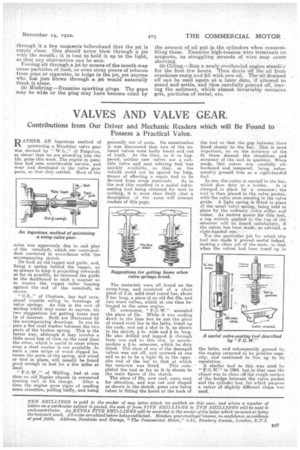VALVES AND VALVE GEAR.
Page 31

If you've noticed an error in this article please click here to report it so we can fix it.
Contributions from Our Driver and Mechanic Readers which will Be Found to Possess a Practical Value.
RATHER AN ingenious method of quietening a Maudslay valve gear was devised by " W.L.," of Paignton, so clever that we are awarding him the 15s. prize this week. The engine in question had seen considerable service, and wear had developed in the valve gear parts, so that they rattled. Most of the noise was apparently due to end play of the camshaft, which our correspondent corrected in accordance with the accompanying sketch.
He took an old tappet and guide, and, fixing a spring behind the tappet, so as always to keep it projecting outwards so far as possible, he fastened the guide to the dashboard in such a manner as to ensure the tappet roller bearing against the end of the camshaft, as shown.
" U.S.," of Clapham, has had occasional trouble owing to breakage of valve springs. As this is the sort of mishap which may occur to anyone, his two suggestions for getting home may be of interest. Both are illustrated by the accompanying drawings. In one he puts a flat steel washer between the two parts of the broken spring. This is the better way, although it may involve a little more loss of time on the road than the other, which is useful in cases where even a steel washer is not available. In such a case strips of wood slipped between the parts of the spring, and wired or tied in place, will usually be found good enough to last for a few miles at least.
" F.G.W.," of Welling, had at one time an old Napier chassis (a converted touring car) in his charge. After a time the engine gave signs of needing some attention, pulling badly, and being generally out of sorts. On examination it was discovered that two of the exhaust valves were badly burnt and out of truth. At the time, as it so happened, neither new valves nor a suitable valve and seat refacing tool, was quickly available, so that, as the vehicle could not be spared for losig, means of effecting a repair had to be
devised from scrap materials. As in the end this resulted in a useful valve. seating tool being obtained for next to nothing, it is more than likely that a description ,)f the same will interest readers of this page.
The materials were all found on the scrap-heap, and consisted of a short piece of I-in, mild steel round bar, about 2 ins, long, a piece of an old flat file, and two worn valves, which at one time belonged to the same engine.
To commence, " F.G.W." annealed the piece of file. While it was cooling down in the lime box he put the piece of round steel bar in the lathe, trued up the ends, and cut a slot in it, as shown in the sketch, in. wide and in. long. He also drilled and tapped it through from one end to this slot, to accommodate a -in. setscrew, which he duly fitted. The stem of one of the damaged valves was cut off, and screwed at one end so as to be a tight fit in the opposite end of the bar to that at which
the setscrew was fitted. This completed the tool so far as it is shown in the main figure of the sketch. The piece of file, now cool, came next for attention, and was cut and shaped as shown in the sketch great care being taken in fitting the horns at the back of
the tool so that the gap between them fitted closely to the bar. This is most important, as on the accuracy of the fit there depend the steadiness and accuracy of the tool in question. When made, this cutter was carefully oilhardened and tempered, being subsequently ground true as a right-handed tool.
In use the cutter is carriedin the bar,
which Les duty as a holder. It is clamped in place by a setscrew; the tool is then placed in the valve pocket, with the valve stem running in the valve guide. A light spring is fitted in place of the usual valve spring, being held in place by the ordinary valve collar and cotter. As motive power for this tool, a tap wrench applied to the top of the setscrew will be found satisfactory, if the cutter has been made, as advised, a right-handed one.
For the particular job for which this tool was made it proved useful indeed, making a clean job of the seats, so that when the valves had been trued up in
the lathe, and subsequently ground in, the engine returned to its pristine capacity, and continued to live up to its reputation. .A similar tool to this was used by " F.G.W." in 1904. but in that case the object was to clean off the rough surface of the bridge between the valve pocket and the cylinder box, for which purpose a cutter of slightly different shape was used.
































